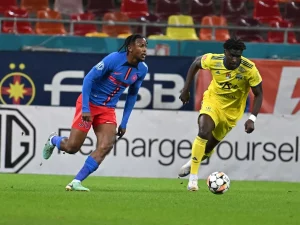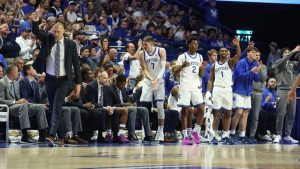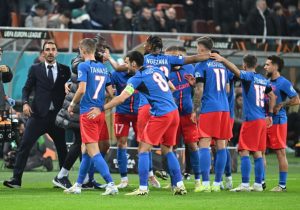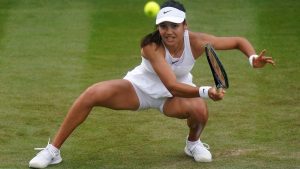
Why I Was Wrong About the North Carolina Tar Heels

Helloooooooooooooooooooooooooo everyone. If you cast your minds back around 3 months ago, you may remember this post I made before the season started detailing my top 50 teams entering the college basketball season. That post has aged………………………….meh? There was certainly some stuff I got right or was close enough on that I would still count it as accurate (Purdue, Houston, UConn w/ Clingan, Iowa, Miss St, Baylor), some stuff where I was on the right path but didn’t commit all the way (Auburn, Dayton, Duke, Tennessee, Illinois, New Mexico), and there was some stuff that I was COMPLETELY FREAKING WRONG ABOUT (The State of Michigan, the State of Utah, the City of Los Angeles, the SEC, the DMV area, San Diego State). Of all the teams I was wrong about however, none have made me look as foolish as North Carolina has. Far be it from me to avoid introspection, I believe that admitting my whiff and analyzing my largest flop would make for interesting content. After watching this team on and off throughout this season and crunching the numbers, I have identified 4 reasons why I missed so badly on the UNC Tar Heels.
Transition Defense
If you’ve been paying attention to this team then you’ve already realized that UNC’s defensive results have been AWESOME this season. While it’s true they’ve been getting some help in that regard (we’ll get to that later), I have been extremely impressed with their defensive effort in this campaign so far. I was going to talk about how their collective effort and commitment when guarding ball screens is so much more consistent compared to last season, but the data shows that the Points Per Possession disparity isn’t nearly as wide as I thought. Instead, the most significant difference between last year’s defense and this year’s defense is in transition. According to Synergy, opponents scored 1.078 PPP and shot 68.5% at the rim in transition last season. This season, opponents are scoring 0.851 PPP and shooting 55.9% at the rim in transition. Just like with what I’ve noticed anecdotally in their PnR coverage, UNC’s excellent effort defending in transition is obvious. There’s been a much greater commitment to getting back on defense with energy, communicating and getting matched up, and picking up the ball early up the floor when compared to last season. The Tar Heels have really improved at making better individual plays at the rim to deter layups in the form of blocks and steals. What’s most impressive is how their bigs can get back on defense immediately after crashing the offensive glass. Clemson has a 4-on-3 in this clip but UNC running a shooter off the 3pt line and rotating under the rim from the weakside allow enough time for Bacot to get back into the play and block the layup attempt. Take a look at this play vs Syracuse too, Bacot & his man start in the same spot off the Davis miss but Armando easily gets down the floor first while having the recognition to get his head around to the outlet pass, contain the drive, and contest the layup. UNC’s ability to pass off slashers seamlessly while sped up is quite impressive. For my last example, check out true freshman #1 Zayden High here. He gets back after going for an offensive rebound, communicates that he’s picking up the trailer, then switches Seth Trimble onto the trailer so he can remain closer to the paint as the primary rim protector, and finally perfectly times a block on the TJ Bamba drive. When a true freshman is doing stuff like this, you know the process and habits are strong.
Identity
I stated that one of my biggest questions/concerns about this UNC team going into the season was that I wasn’t sure what this team’s identity would be. I didn’t see this level of defense coming with this roster, they were 99th in tempo on Kenpom last year, and I was skeptical about their starting group committing to the offensive glass outside of Bacot. In hindsight, I really should have seen this coming. With 3 highly skilled ball handlers in RJ Davis, Elliot Cadeau, and Harrison Ingram, along with a head coach who was a part of Roy Williams’ bench for so long, it’s no wonder that the Heels have ramped up the running this season. Honestly the fact that they’re only 50th in tempo on Kenpom is pretty surprising considering they run off EVERYTHING: Misses, makes, turnovers, you name it. Few teams get into their offense faster than North Carolina. Like I said, having all those primary creators out on the floor who can grab n go or receive a quick outlet and race to the hoop makes them an extremely dangerous transition team. I even saw a transition possession where Jae’lyn Withers led the break and generated an open 3pt make for RJ Davis. There’s nothing particularly special they do in transition tactically, they fill a spot on each wing, each corner, and the big runs to the ball-side block, but they do it with such speed, force, and skill that teams just cannot keep up with them over 40 minutes. Outside of simply running more often, the Tar Heels have also been much more efficient in transition this year compared to last year. According to Synergy, UNC was 12th in the ACC with 1.025 PPP in transition. This year, they are currently 4th in the ACC at 1.107 PPP in transition. Overall, their emphasis on dominating both ends of the floor in transition is a microcosm of their identity. Their talent gets them in the door but it’s their hard work that keeps them among the nation’s best. This is the best and most consistent effort I’ve seen out of any of Hubert Davis’s 3 UNC teams, especially on defense.
Harrison Ingram
Speaking of things I got wrong, boy was I wrong about Harrison Ingram’s impact on this team. I felt that Ingram had a lot of room for improvement at both ends of the floor at Stanford, but now he’s looking like one of the most improved players in the country. I think he’s really upped his game when defending the ball, allowing UNC to be much more switchable 1 through 4. At least when I’ve watched UNC this year, it hasn’t been hard to tell that Harrison’s ability to cycle through different players on the defensive end has limited how many advantages opposing offenses can create. He’s looking like a much quicker lateral mover than he ever did at Stanford, in my opinion. Harrison’s been fantastic on the offensive end as well. It helps that he got off to a scorching start from 3pt land in non-conference play with a 3P% in the mid-40s. He has predictably cooled off since then, but the threat he poses from beyond at the 4 just adds to the space RJ Davis has in ball screens or Armando Bacot has on the block. His shooting isn’t what got him on this post, however. It’s Harrison’s work inside the arc on the block that got him here, as Ingram is one of the best post players in the country. Harrison is in the 84th percentile nationally on Post Up PPP generated according to Synergy at 1.131 PPP. He was only 27th percentile at 0.763 PPP last year and 26th percentile at 0.734 PPP during his freshman season. He combines the skill of a primary creator and the size of someone 6’8 230 lbs to dominate the interior as both a scorer and passer. It doesn’t matter whether he goes to a turnaround J, a jump hook after posting from a double staggered pindown, or a dropstep through contact after feeling a smaller defender on his back, Harrison can get buckets in any fashion on the block. I love it when UNC allows him to hunt switches too. Here, you can see UNC goes to an empty-side ball screen out of HORNS to get Ingram posted on the smaller guard and let him go to work with a whole side of the floor to himself. The danger he poses causes him to get triple teamed, but he stays patient, keeps his dribble alive, and uses his size and IQ to identify the defender committing diagonally and find the open shooter. Ingram hasn’t needed to flex his PnR passing chops at UNC the way he needed to at Stanford, but he’s adapted that to his post game in a way that makes UNC’s offense extremely versatile. You cannot load up to him when he’s posting up on the left block because he’ll just rip a right-handed skip pass to the opposite corner for a wide open 3. The box score stats may not be crazy eye-popping, but his impact on this team cannot be understated.
Luck
NO, I’m not saying I would have been right about the Tar Heels if it weren’t for their pesky defensive shooting fortune. However, it’s basically impossible to deny that this team hasn’t been lucky with opponent shooting. Let me go through some numbers to show you what I mean. Almost half (46.6%) of the total opponent Catch-n-Shoot 3PAs have been of the unguarded variety according to Synergy. For reference, the Tar Heels are 196th in unguarded opponent Catch-n-Shoot 3PAs per game at 8.3. Despite this, opponents are shooting 31.3% on unguarded C&S 3Ps. Teams are getting a solid amount of good looks from distance against this team, but those just aren’t going in. For even more evidence, opponents have shot below their season-average 3P% in 15 of the 19 games UNC has played in so far this season. Opponents have shot 21.1% or lower from distance in 6 of UNC’s 8 ACC games. Do I think the Tar Heels’ defense is really good? Yes. Has their defense been quite lucky? Also yes.
So there you have it, four reasons why I was utterly wrong about this season’s North Carolina Tar Heels team. What do you think of UNC this year and their chances of winning the ACC or even the national title this season? Did you have any preseason takes that have aged well or horribly? Let me know in the comments and thank you for reading.






